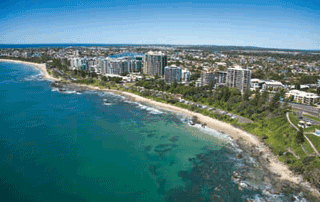Quote of the Week
“Queensland, SA and WA are the biggest improvers, with their success in suppressing the virus appearing to have supported their economic performance. Victoria and ACT suffered more in their rankings due to the uncertainty and change brought by the Pandemic.”
CommSec Chief Economist Craig James, discussing the State of the States report.
Investors Join Boom Market
 Investors are tipped to return to the property market throughout 2021 as rising prices and yields in suburbia and the regions offer an attractive proposition. The latest loans data suggests investor activity is already rising.
Investors are tipped to return to the property market throughout 2021 as rising prices and yields in suburbia and the regions offer an attractive proposition. The latest loans data suggests investor activity is already rising.
The suburbs and regions are attracting investors as prices boom and vacancy rates push below 1% in many areas, putting upward pressure on rents.
“Investors have often been the last segment of the market to turn,” says AMP chief economist Shane Oliver. “Momentum in prices is attracting investors back, but more so in the smaller cities.”
Investors have been largely absent since 2019, dropping to an 18-year low in May 2020. Owner-occupiers and first-home buyers filled the gap, reducing investors market-share to below 30%.
But NAB says rising confidence from the resilience of prices through the pandemic is spurring investors back. “We’ve seen positive signs for investors in recent months, with lending demand picking up sharply towards the end of last year,” a spokesperson said.
Stats Support Rise Of Regions
 Regional towns across Australia are leading the way when it comes to house price gains as growing numbers of city residents make a tree change or sea change to smaller urban areas.
Regional towns across Australia are leading the way when it comes to house price gains as growing numbers of city residents make a tree change or sea change to smaller urban areas.
Driven by the work-from-home trend, a desire for homes with larger living space and gardens, and societal changes brought on by the pandemic, regional towns are proving popular for home-buyers.
In 2020 homes in regional areas rose by 7% on average, a capital gain three times that of the average rise for capital cities, according to research from CoreLogic.
“Regional housing markets had generally under-performed relative to the capital city regions over the past decade, but 2020 saw regional housing values surge as demand outweighed supply,” research director Tim Lawless says.
Some regional areas, mostly coastal towns, have performed as well as Australian cities over a longer, 10-year period in terms of annualised capital gains. Numerous regional centres in NSW, Queensland and Victoria have matched their capital cities in the past five years.
75% Of Places Tipped To Boom
 Property analysts believe the RBA’s forecast of 30% price growth over three years will materialise in three-quarters of locations nationwide.
Property analysts believe the RBA’s forecast of 30% price growth over three years will materialise in three-quarters of locations nationwide.
The Reserve Bank says a permanent 1 percentage point reduction in the official interest rate could increase housing prices by 30% by 2023.
Market analysts Arjun Paliwal and Kent Lardner believe the bank’s predictions are fairly accurate.
“With what we can see today based on recent shifts in inventory levels, we would be comfortable in saying the RBA forecast will apply in 75% of regions,” they say.
According to their analysis of inventory level trends over the last two years, a substantial decline in stock levels is evident, creating high price pressure.
“There has been a dramatic decline in stock levels relevant to sales volumes,” they say. “This change is creating many high pressures. Most regions across Australia are seeing a decline in days on market. This is likely to flow on to prices and a reduction in vendor discounting.”
States In Battle For Top Spot
 The economic performance race has tightened, according to the latest CommSec State of the States Report.
The economic performance race has tightened, according to the latest CommSec State of the States Report.
Tasmania continues to lead, cementing its place as the best performing economy. While ACT has held on to the second spot, there is now little to separate South Australia, Victoria, Queensland, NSW and WA.
The State of the States report uses the latest data to provide an economic snapshot of how Australia’s state and territory economies are performing. Tasmania has topped the rankings for the fourth consecutive quarter and leads on four of the eight indicators assessed.
The ACT economy remains in second position, continuing its best performance in the economic rankings in three years.
SA is now in equal third spot with Victoria. The joint third ranking for SA is its highest position in over a decade while the equal sixth ranking for NSW is its lowest position in eight years, closely following Queensland in the fifth spot. The Northern Territory continues to lag the other states in the economic performance rankings.
Australian Economy To Grow Faster
 Australia’s economy will grow faster than previously forecast this year, as global growth accelerates following the roll-out of coronavirus vaccines, the International Monetary Fund says.
Australia’s economy will grow faster than previously forecast this year, as global growth accelerates following the roll-out of coronavirus vaccines, the International Monetary Fund says.
In new forecasts released this week, the Washington-based organisation says it now expects global output to increase 5.5% this year, higher than the 5.3% it expected in October. The global economy shrunk 3.5% last year, less than the 4.4% forecast, it says.
The Australian economy is now projected to grow 3.5 % this year — 0.5% higher than forecast in October – and 2.9% in 2022.
The IMF says the increased outlook for 2021 reflects “additional policy support in a few large economies and expectations of a vaccine-powered strengthening of activity later in the year, which outweigh the drag on near-term momentum due to rising infections.
“The upgrade is particularly large for the advanced economy group, reflecting additional fiscal support—mostly in the United States and Japan—together with expectations of earlier widespread vaccine availability.”













